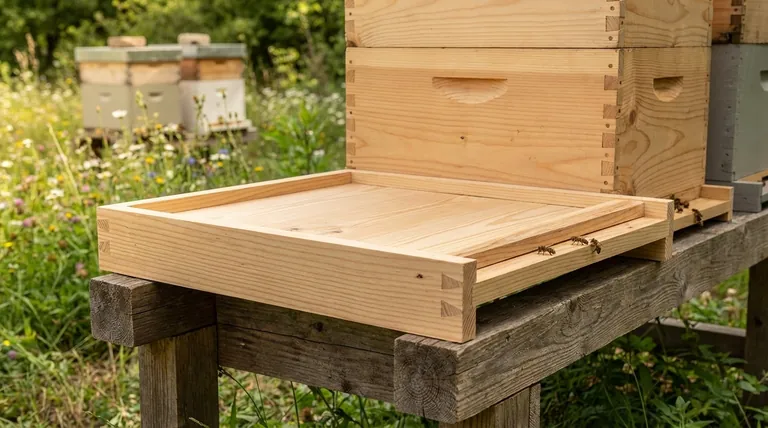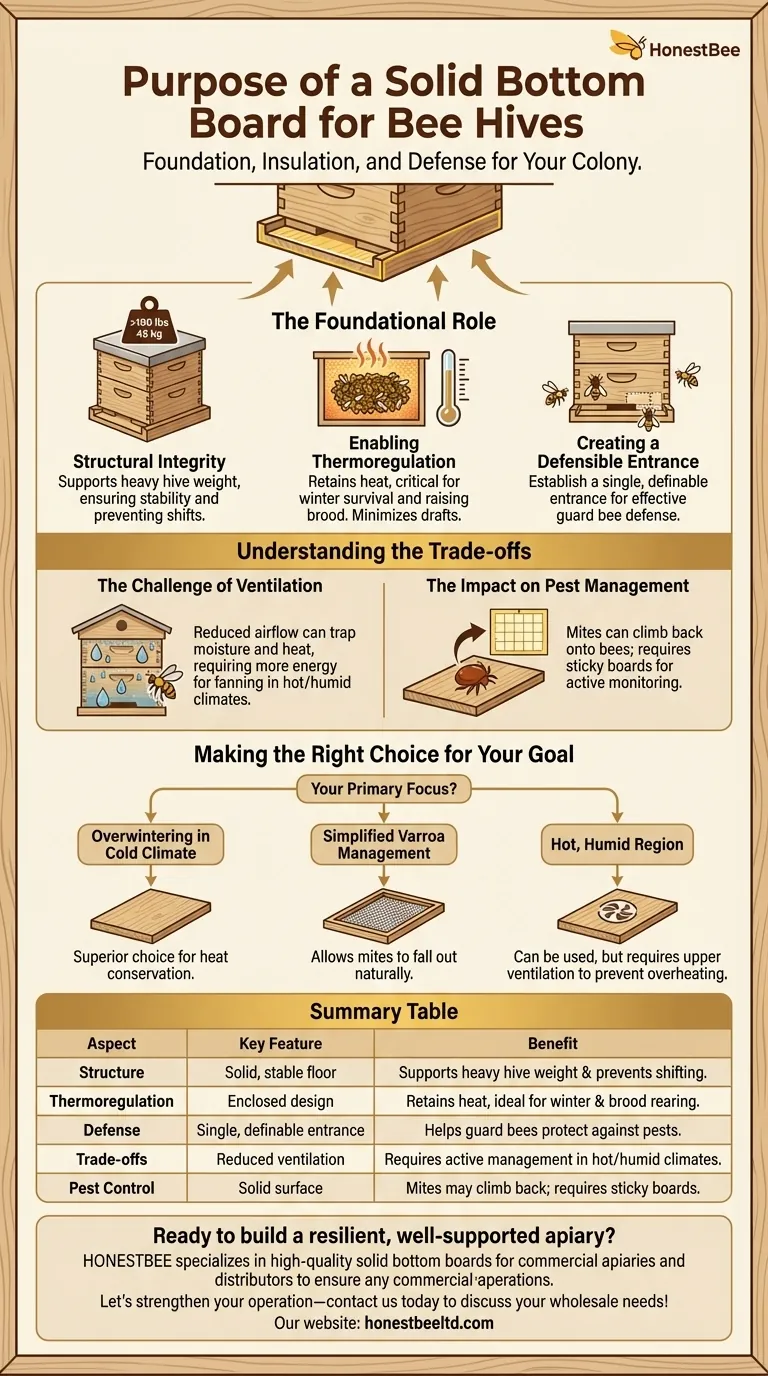In short, a solid bottom board serves as the floor and foundation for a beehive, providing structural support while creating a contained environment that helps the bees manage their internal temperature and defend their colony. It is the traditional base upon which the rest of the hive components rest.
The core purpose of a solid bottom board is to create a more enclosed, insulated hive cavity. This helps the colony retain heat, which is critical for surviving winter and raising brood, but it requires more active management from the beekeeper regarding ventilation and pest control.

The Foundational Role of a Solid Bottom Board
A bottom board is more than just a floor; it is a critical component that defines the hive's immediate environment. Its design directly influences the colony's health, defense, and ability to regulate its internal conditions.
Providing Structural Integrity
The solid bottom board is the literal foundation of the hive. It must be strong enough to support the immense weight of multiple brood boxes and honey supers, which can easily exceed 100 pounds (45 kg).
This stability ensures the hive remains secure and level, preventing shifts that could create unwanted gaps or crush bees.
Enabling Thermoregulation
A key advantage of a solid floor is heat retention. The enclosed space minimizes drafts and helps the bee cluster maintain the stable, warm temperatures necessary for raising young bees (brood) and surviving cold winters.
This design closely mimics the insulated cavity of a hollow tree, the honey bee's natural nesting choice.
Creating a Defensible Entrance
A solid bottom board establishes a single, well-defined entrance. This allows the colony's guard bees to effectively monitor and defend the hive against robbing insects, predators, and other threats.
Beekeepers can easily modify this entrance with a reducer, making it smaller for young or weak colonies to better protect their home.
Understanding the Trade-offs
While beneficial for insulation and defense, the solid bottom board's enclosed nature presents specific challenges that a beekeeper must manage.
The Challenge of Ventilation
The primary trade-off is reduced airflow. In hot and humid climates, a solid bottom board can trap moisture and heat, forcing the bees to expend significant energy fanning to cool the hive and prevent condensation.
Poor ventilation can contribute to hive stress and create conditions favorable for certain bee diseases.
The Impact on Pest Management
This design makes monitoring for varroa mites—the most significant pest for honey bees—more difficult. Unlike a screened bottom board where mites can fall out of the hive, mites that fall onto a solid board can climb back onto a host bee.
To perform mite counts, a beekeeper must insert a "sticky board" to trap and count the fallen mites, which is a more active management step.
Making the Right Choice for Your Goal
The decision between a solid or screened bottom board depends entirely on your local climate and beekeeping philosophy.
- If your primary focus is overwintering in a cold climate: A solid bottom board is often the superior choice for its ability to help the colony conserve heat.
- If your primary focus is simplified varroa mite management: A screened bottom board offers a significant advantage by allowing some mites to fall out of the hive naturally.
- If you are in a hot, humid region: A solid bottom board can still be used, but you must be prepared to provide upper ventilation to prevent overheating and moisture buildup.
Ultimately, choosing a solid bottom board means prioritizing insulation and defensibility while accepting the need for more hands-on ventilation and pest management.
Summary Table:
| Aspect | Key Feature | Benefit |
|---|---|---|
| Structure | Solid, stable floor | Supports heavy hive weight and prevents shifting |
| Thermoregulation | Enclosed design | Retains heat, ideal for winter survival and brood rearing |
| Defense | Single, definable entrance | Helps guard bees protect against pests and predators |
| Trade-offs | Reduced ventilation | Requires active management in hot/humid climates |
| Pest Control | Solid surface | Mites may climb back; requires sticky boards for monitoring |
Ready to build a resilient, well-supported apiary? At HONESTBEE, we specialize in supplying durable, high-quality solid bottom boards and other essential beekeeping equipment to commercial apiaries and distributors. Our products are designed to help your colonies thrive through optimal insulation and structural integrity.
Let’s strengthen your operation—contact us today to discuss your wholesale needs!
Visual Guide

Related Products
- Langstroth Screen Bottom Board for Beekeeping Wholesale
- HONESTBEE Professional Frame Wiring Board and Jig
- Australian Pine Wood Langstroth Screen Bottom Board for Wholesale
- Professional Drop-Style Hive Handles for Beekeeping
- Professional Frame Preparation: The HONESTBEE Electric Wire Embedder
People Also Ask
- What are the benefits of a screened bottom board? Boost Hive Health & Control Varroa Mites
- How does a screened bottom board assist with temperature control and pest management? A Key Tool for Modern Beekeeping
- How should the screened bottom board be used throughout the year? A Guide for Healthy Hives
- What are the assembly options for the Cypress Screened Bottom Board? Ready-to-Use for Immediate Hive Health
- What are the main benefits of using a Screened Bottom Board in beekeeping? Enhance Hive Health & Productivity



















